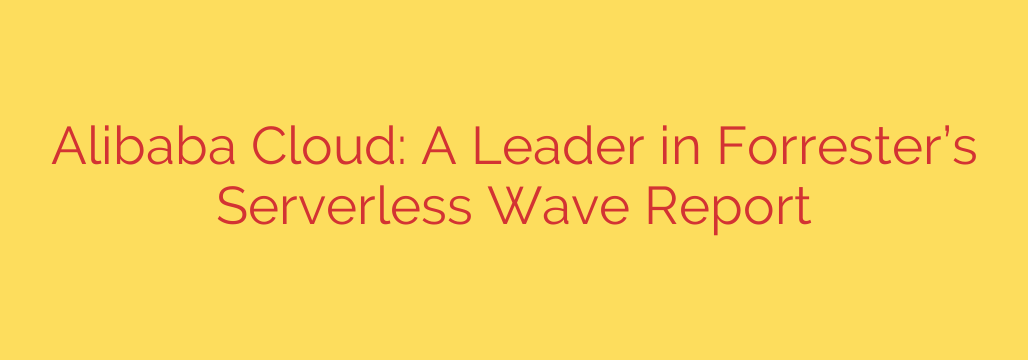
Unpacking the Power of Serverless: How Leading Platforms are Redefining Cloud Computing
The world of cloud computing is in a constant state of evolution. For years, the focus was on virtual machines and containers, which freed businesses from managing physical hardware. Today, the next major shift is well underway: serverless computing. This transformative approach allows developers to build and run applications without ever thinking about the underlying servers, leading to unprecedented efficiency and innovation.
A recent, comprehensive evaluation by a leading global research and advisory firm has highlighted the key players shaping this landscape. The analysis confirms that a mature and robust serverless offering is no longer a niche feature but a cornerstone of a competitive cloud platform. Let’s explore what serverless computing really means and what sets a top-tier platform apart from the rest.
What is Serverless Computing, and Why Does It Matter?
Despite the name, serverless computing does, in fact, use servers. The key difference is that the cloud provider is entirely responsible for managing them. Developers simply write and upload their code as individual “functions.” These functions are then executed automatically in response to specific events or “triggers”—such as a user uploading a file, a new entry appearing in a database, or a scheduled time.
This event-driven model offers several game-changing advantages:
- Ultimate Cost-Efficiency: With a serverless architecture, you transition to a pure pay-per-use model. You are billed only for the precise compute time your function runs, down to the millisecond. When your code isn’t running, you pay nothing. This eliminates the cost of idle server capacity.
- Automatic and Seamless Scaling: A leading serverless platform handles all scaling automatically. Whether your application receives ten requests or ten million, the platform instantly provisions the necessary resources to handle the load and then scales back down to zero when the demand subsides.
- Increased Developer Productivity: By abstracting away all infrastructure management—including provisioning, patching, and maintenance—developers can focus exclusively on writing code that delivers business value. This dramatically shortens development cycles and accelerates time-to-market.
- Reduced Operational Overhead: Your operations team is freed from the mundane and time-consuming task of server management, allowing them to focus on higher-level strategic initiatives like security, monitoring, and performance optimization.
Hallmarks of a Top-Tier Serverless Platform
According to the in-depth industry analysis, not all serverless offerings are created equal. The platforms that lead the pack are distinguished by a combination of powerful technology, a rich ecosystem, and a strong strategic vision. Here are the core strengths that define a leader in the serverless space:
1. A Comprehensive Function-as-a-Service (FaaS) Offering
At the heart of any serverless platform is its Function-as-a-Service (FaaS) engine. A top-tier provider offers a highly performant and versatile FaaS solution. This includes support for a wide array of programming languages, flexible configuration options, and the ability to handle both simple, short-lived tasks and more complex, long-running computations. The platform was specifically recognized for its advanced FaaS capabilities and a strong vision for its evolution.
2. Deep and Seamless Ecosystem Integration
A function rarely exists in isolation. Its true power is unlocked when it connects with other cloud services. Leading platforms provide tight, native integration between their serverless functions and a vast portfolio of other tools, including:
- Databases (SQL and NoSQL)
- Object Storage
- API Gateways
- Message Queues
- AI and Machine Learning services
This seamless integration allows developers to build sophisticated, event-driven applications with minimal friction.
3. Exceptional Developer Experience
Making powerful technology easy to use is crucial for adoption. Leaders in the serverless market invest heavily in the developer experience. This means providing intuitive user interfaces, comprehensive command-line tools (CLIs), robust APIs, and a wealth of documentation and tutorials. The goal is to simplify the entire development, debugging, and deployment lifecycle.
4. Robust Security and Governance
As serverless adoption grows within enterprises, security becomes paramount. A leading platform must offer granular security controls, including precise identity and access management (IAM) roles for functions, network isolation, and built-in protection against common threats. The ability to maintain strong governance and compliance is a non-negotiable feature for any serious business application.
Actionable Security Tips for Your Serverless Journey
As you adopt serverless technologies, keeping your applications secure is critical. Here are a few essential tips:
- Embrace the Principle of Least Privilege: Each function should be granted only the exact permissions it needs to perform its task. If a function only needs to read from a specific database table, do not give it write access or access to other tables.
- Secure Your Triggers: The events that trigger your functions are a potential entry point. Secure your API gateways with authentication and authorization, and validate all incoming event data to prevent injection attacks.
- Manage Your Dependencies: Your function’s code often relies on third-party libraries. Regularly scan these dependencies for known vulnerabilities and update them promptly to patch any security holes.
- Monitor and Log Everything: Implement robust logging to track every function invocation, error, and outcome. Centralized monitoring can help you detect anomalous behavior or security threats in real-time.
Serverless computing represents a fundamental paradigm shift in how we build and deploy software. By removing the burden of infrastructure management, it empowers organizations to innovate faster and operate more efficiently than ever before. As industry analysis shows, the platforms that deliver a powerful, integrated, and developer-friendly experience are the ones paving the way for the future of cloud-native development.
Source: https://datacenternews.asia/story/alibaba-cloud-named-leader-in-forrester-wave-serverless-report








